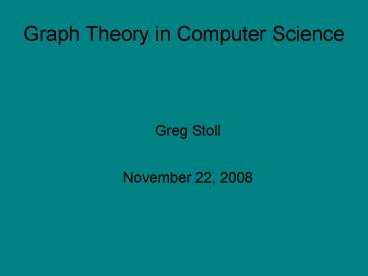Graph Theory in Computer Science - PowerPoint PPT Presentation
Title:
Graph Theory in Computer Science
Description:
What's the fewest number of colors that are needed to color a given graph? Graph colorings ... are longer) We can do this by starting at the bottom and always ... – PowerPoint PPT presentation
Number of Views:303
Avg rating:3.0/5.0
Title: Graph Theory in Computer Science
1
Graph Theory in Computer Science
- Greg Stoll
- November 22, 2008
2
Today's Topics
- Graph colorings
- Huffman encoding
3
Graph colorings
4
Graph colorings
5
Graph colorings
- What's the fewest number of colors that are
needed to color a given graph?
6
Graph colorings
- A clique of size n is a graph with n vertices
where all vertices have edges between them.
7
Register allocation
- Modern computers do operations (, -, , etc.) on
registers. Fixed number of these (x86
architecture has 8, x64 has 16). When compiling
code, need to assign variables to registers to
use them.
8
Register allocation
9
Register allocation
10
Register allocation
- In fact, this is always true for interval graphs
the number of registers needed (i.e. the number
of colors to color the graph) is equal to the
size of the largest clique!
11
Register allocation
- Unfortunately, even finding the largest clique in
a graph is NP-hard, but a greedy algorithm does
pretty well.
12
Register allocation
- Another problem what if there aren't enough
registers?
13
Worksheet, part 1
- Work on questions 1-6 on the worksheet!
14
Cookies!
- Mmmm....
15
Sending a message
- On a computer, all you have are bits (0's and
1's). How can you send a text message to another
computer?
16
ASCII encoding
- ASCII is a standard way to turn characters into
bits. - A 65 01000001
- B 66 01000010
- ...
- Z 90 01011010
17
Modified ASCII
- What if we just want to send letter and a little
punctuation? We can use a smaller code - a 0 00000
- b 1 00001
- ...
- ltspacegt 26 11010
- 5 bits means 25 32 characters
18
Modified ASCII
- Our modified ASCII uses 5 bits per character.
- Sample message hello mom, how are you? is 22
characters 5 bits/character 110 bits. - How could we reduce the average number of bits
per character?
19
Shrinking the message
- Not all letters are created equal. e is much
more common than x in most English text. - We could take advantage of this if we made the
code for e smaller than the code for x.
20
Shrinking the message
- o and are the most commonly used letters in
our sample message. Let - o 0
- 1
- m 00
- ....
- Will this work?
21
Prefix-free code
- A prefix-free code is one in which no code word
is a prefix of another. - o 0
- 1
- m 00
- is not prefix free, since o0 is a prefix of
m00.
22
Binary tree
- A binary tree is a common data structure where
each node has up to two children.
23
Binary tree
- What if we assign a character to each leaf?
24
Huffman encoding
- We want a way to build up a binary tree where the
least common characters are lower. (i.e. their
code words are longer) We can do this by
starting at the bottom and always combining the
least common two characters, and continuing until
we've formed a binary tree.
25
Huffman encoding
- Example hello mom, how are you?
26
Huffman encoding
- Using Huffman encoding lets us send the message
in 78 bits, as opposed to 110. With longer
message, you can get even greater savings.
27
Worksheet, part 2
- Work on questions 7-12 on the worksheet!































